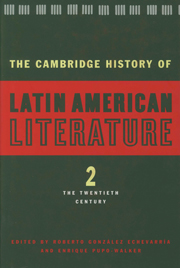Book contents
- Frontmatter
- Introduction to Volume 2
- 1 Modernist poetry
- 2 Modernist prose
- 3 The Vanguardia and its implications
- 4 The literature of Indigenismo
- 5 Afro-Hispanic American literature
- 6 The Criollista novel
- 7 The novel of the Mexican Revolution
- 8 The Spanish American novel from 1950 to 1975
- 9 The Spanish American novel: recent developments, 1975 to 1990
- 10 Spanish American poetry from 1922 to 1975
- 11 The modern essay in Spanish America
- 12 Literary criticism in Spanish America
- 13 The autobiographical narrative
- 14 The twentieth-century short story in Spanish America
- 15 Spanish American theatre in the twentieth century
- 16 Latin American (Hispanic Caribbean) literature written in the United States
- 17 Chicano literature
- Index
- Bibliographies
- References
13 - The autobiographical narrative
Published online by Cambridge University Press: 28 March 2008
- Frontmatter
- Introduction to Volume 2
- 1 Modernist poetry
- 2 Modernist prose
- 3 The Vanguardia and its implications
- 4 The literature of Indigenismo
- 5 Afro-Hispanic American literature
- 6 The Criollista novel
- 7 The novel of the Mexican Revolution
- 8 The Spanish American novel from 1950 to 1975
- 9 The Spanish American novel: recent developments, 1975 to 1990
- 10 Spanish American poetry from 1922 to 1975
- 11 The modern essay in Spanish America
- 12 Literary criticism in Spanish America
- 13 The autobiographical narrative
- 14 The twentieth-century short story in Spanish America
- 15 Spanish American theatre in the twentieth century
- 16 Latin American (Hispanic Caribbean) literature written in the United States
- 17 Chicano literature
- Index
- Bibliographies
- References
Summary
Autobiography in Spanish America is a much neglected form. This is not because, as has so frequently and thoughtlessly been asserted, autobiography is unusual, nor is it because Hispanic writers, for elusive “national” characteristics, are not prone to recording their lives on paper. The perceived scarcity of life stories written in the first person is less a matter of quantity than a matter of attitude, for autobiography is as much a way of reading as it is a way of writing. Thus, one might say that, whereas there are and have been a good many autobiographies written in Spanish America, they have not always been read autobiographically: filtered through the dominant discourse of the day, they have been hailed either as history or as fiction, and rarely considered as occupying a space of their own.
First-person narratives abound in Spanish American colonial literature. Chronicles of discovery and conquest, especially those involving some measure of self-awareness on the part of their authors, might be seen as precursors of the autobiographical mode. In the same way, self-reflexive documents such as Juana Inés de la Cruz’s letter to the Bishop of Puebla, Respuesta a Sor Filotea (1691; pub. 1700), or confessional depositions before the tribunals of the Inquisition, given the vindication of self they propound, may be considered autobiographies. Nevertheless, the fact that the above mentioned texts were conceived primarily for a privileged, institutional, reader (the King, the church) having power over writer and text, and the fact that the narration of self was more a means to achieve a goal than the goal itself, considerably modify the textual self-confrontation and crisis that we have come to recognize as the mark of autobiographical writing.
- Type
- Chapter
- Information
- The Cambridge History of Latin American Literature , pp. 458 - 464Publisher: Cambridge University PressPrint publication year: 1996

